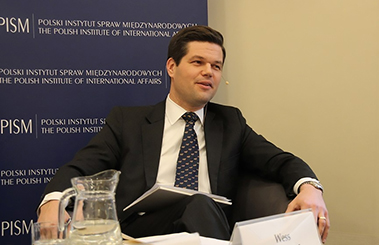
What’s Washington Really Doing in Armenia?
By F. William Engdahl
3 May 2018
There has been considerable speculation in recent days as to whether the recent and ongoing protests across former Soviet Armenia constitute another Washington Color Revolution destabilization or whether it represents simply the angry revolt of citizens fed up with the deep corruption and lack of economic development under the regime of Prime Minister Serzh Sargysan. Following days of large protests, the former President was forced to resign on April 23, declaring, “Nikol Pashinyan was right. I was wrong.” Armenia is an integral member of Russia’s Eurasian Economic Union and were it to come under control of a pro-NATO opposition could bring a strategic problem for Moscow to put it mildly. The issue is significant .
Ironically, what nominally sparked the protests was the action of Sargysan to in effect do what Turkey’s Erdogan has done, only in reverse. He and his parliamentary majority party managed to strip the office of President of almost all but ceremonial roles, while giving actual decision powers to the office of Prime Minister. That he managed just before he himself became Prime Minister. Reaction from Moscow to the ongoing protests until now has evidently been muted following a statement that it won’t get involved in Armenian internal affairs.
At this point, despite the fact that Sargysan resigned as Prime Minister and did not submit himself as candidate to oppose Pashinyan in the May 1 parliament vote, Pashinyan fell short of the majority needed to be named Prime Minister. As of this writing he has called for a total blockage of traffic and government buildings by “peaceful acts of civil disobedience.” He told a crowd outside Parliament after the failed vote was announced, “Tomorrow total strike is declared. We block all the streets, communications, subway and the airports starting from 08:15. Our struggle cannot end in a failure.”
Color Revolution?
What evidence points to a directed Washington intervention into a country strategic for Moscow? First we have the established presence of an office in Yerevan of the Open Society Foundations-Armenia of George Soros. As the anti-government protests built in size on April 17, several NGOs signed an open letter to the government warning that they had identified probable government-backed protest disruptors and warned against their deployment against the peaceful protestors.
The call was signed among others by Helsinki Committee of Armenia, part of Helsinki Committees which in part is funded by George Soros’ Open Society Foundations. The call was also signed by Soros’ Open Society Foundations – Armenia.
This past February the Soros OSF-Armenia announced a joint project with the European Union designed to, “focus on engaging youth, young activists and journalists. It will serve as a bridge between the established human rights advocates in Armenia and younger generations of activists interested in gaining more expertise in defending rights of the RA citizens.”
Another signer to the warning statement to the Armenian government was an Armenian NGO calling itself the Protection of Rights Without Borders NGO. It turns out that that NGO is also funded not only by Soros’ OSF-Armenia, but also by the EU and by the US State Department USAID, an organization as I describe in my newest book, Manifest Destiny: Democracy as Cognitive Dissonance, that is frequently tied to US Government regime change destabilizations and Color Revolutions.
The fact that Open Society Foundations-Armenia and others signed such a statement directly tied to unfolding events on the streets of Yerevan suggest at the least more than an academic interest in the growing protests.
What about the role of other US-based NGOs in Armenia? The leading US regime-change NGO, National Endowment for Democracy, created in the 1980’s in the words of Allan Weinstein, one of its founders, to do what the CIA used to do but privately, has become far less forthcoming about its grants. Nonetheless some research reveals that the NED has also funded numerous programs in Armenia ranging from promoting rule of law and government accountability in Armenia, as well as funding a 2017 program for Armenian journalists to show “how Georgia benefits from its associations with the EU and how Armenia does not reap similar advantages from the Eurasian Economic Union.” In another generous grant the NED gave more than $40,000 in 2017, a hefty sum in the depressed Armenian economy, to finance Armenian Times Newspaper as they put it, “to improve the quality and increase the availability of independent news…
Now if we add to the established presence of Washington-financed NGOs the fact that the US State Department actively is in contact with opposition leader Nikol Pashinyan during the recent protests it becomes even more likely we are witnessing a variation of Washington’s Color Revolution. On April 30, the day before the fateful parliament vote, US State Department Assistant Secretary of State for European and Eurasian Affairs, A. Wess Mitchell, noted he had initiated a phone discussion with opposition Civil Contract MP, Nikol Pashinyan. In his official statement Mitchell merely stated that the “US government looks forward to working closely with the new government in Armenia, aiming to further deepen the decades-long US-Armenian relationship.”
Wess Mitchell sits in the post held under Obama by the infamous neoconservative Ukraine Color Revolution instigator, Victoria Nuland. It seems he is the continuity of Nuland as well. Mitchell came to the State Department post in 2017 from something called the Center for European Policy Analysis (CEPA) where he was CEO and which he actually founded. Now things get interesting.
The CEPA, a Washington think tank founded in 2004 at the time the US was deep involved in the Ukraine Orange Revolution, describes its mission being “to promote an economically vibrant, strategically secure and politically free Central and Eastern Europe with close and enduring ties to the United States.” A major program of CEPA is “dedicated to monitoring and exposing Russian disinformation in the countries of Central and Eastern Europe.”
Indeed Assistant Secretary of State Mitchell comes from a Washington anti-Russian think tank whose funders include NATO, US Defense Department, National Endowment for Democracy, the major military industry giants including Lockheed Martin, Raytheon, Boeing, BAE Systems, Bell Helicopter. Notably after an article in the Russian state RT on the funding of CEPA that portion of their website seems to have vanished into cyber nirvana.
In addition to Russophobe Mitchell in admitted contact with opposition leader Nikol Pashinyan, US Ambassador to Armenia, Richard Mills, a former Senior “Democracy Advisor” (sic) at the US Embassy in Iraq owes his job to Victoria Nuland who reportedly brought Mills to Yerevan to help bring Armenia, like Ukraine, into the US sphere and away from Russia. Mills reportedly played a key role in brokering the sale of an Armenian Vorotan Hydro complex to American company that triggered a failed 2015 attempt at a Color Revolution protest over the ensuing 16% hike in electricity prices. US-funded NGOs argued the main reason for the rising electricity was Russia whose Gazprom dominates the Armenian energy market. Protests were spread then using the social media hash tag #ElectricYerevan.
This time all indications point to a far more refined remake of a US Color Revolution, this time with a credible leader, 42-year old journalist and prison veteran from earlier anti-government actions Pashinyan. Pashinyan has been careful to declare if made Prime Minister he would not take Armenia out of Russia’s Eurasian Economic Union. On May 1 he declared, “We consider Russia as a strategic ally, our movement does not create threats for this…If I am elected [as the prime minister], Armenia will remain a member of the Eurasian Economic Union and the Collective Security Treaty Organization.”
At this juncture it is clear, despite Nikol Pashinyan’s soothing words, that the Armenian events are not at all good news for Moscow whose direct options are for the moment limited.
Why Armenia?
Armenia is a strategic ally of Moscow ever since the dissolution of the Soviet Union in 1991. It is bordered by two hostile countries—Azerbaijan and Turkey. Her other neighbors are Iran and Georgia. With the situation in Georgia precarious since the US staged a Color Revolution in 2003 bringing the pro-NATO Mikhail Saakashvili into power, were Armenia to come under influence of a leader determined to pull the country away from Russian dependence, its major trading partner and investor, it would result in some kind of civil war.
Already there are voices in Azerbaijan gleefully anticipating such an outcome. On May 1 as the Armenian parliament refused to vote Pashinyan in as Prime Minister, Azeri parliament member Gudrat Hasanguliyev warned that the situation in Armenia might turn into a civil war. He insisted that Azerbaijan should be prepared to use such a civil war as a chance to retake the secessionist Nagorno-Karabakh whose population is majority Armenian.
Since the Russian-brokered end to a war between a US-backed Azeri army and Armenia in 1994 the Nagorno-Karabakh enclave has been in an uneasy ceasefire. It was broken briefly in 2016 when Azeri forces tried a military occupation of Nagorno-Karabakh before being forced to backdown.
All evidence at this point suggests there is a dirty hand of the US NGOs and State Department pushing to take advantage of the internal discontent inside Armenia to further weaken Russia and its Eurasian Economic Union by at the minimum creating unrest and chaos in Armenia. If this is so will be clear soon enough.
F. William Engdahl is strategic risk consultant and lecturer, he holds a degree in politics from Princeton University and is a best-selling author on oil and geopolitics, exclusively for the online magazine “New Eastern Outlook”
